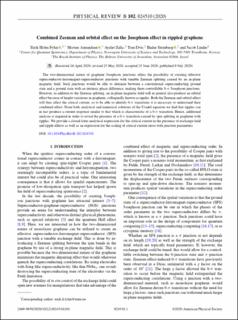| dc.contributor.author | Fyhn, Eirik Holm | |
| dc.contributor.author | Amundsen, Morten | |
| dc.contributor.author | Zalic, Ayelet | |
| dc.contributor.author | Dvir, Tom | |
| dc.contributor.author | Steinberg, Hadar | |
| dc.contributor.author | Linder, Jacob | |
| dc.date.accessioned | 2021-02-09T08:36:04Z | |
| dc.date.available | 2021-02-09T08:36:04Z | |
| dc.date.created | 2020-09-06T12:29:27Z | |
| dc.date.issued | 2020 | |
| dc.identifier.issn | 2469-9950 | |
| dc.identifier.uri | https://hdl.handle.net/11250/2726758 | |
| dc.description.abstract | The two-dimensional nature of graphene Josephson junctions offers the possibility of creating effective superconductor-ferromagnet-superconductor junctions with tunable Zeeman splitting caused by an in-plane magnetic field. Such junctions would be able to alternate between a conventional superconducting ground state and a ground state with an intrinsic phase difference, making them controllable 0-π Josephson junctions. However, in addition to the Zeeman splitting, an in-plane magnetic field will in general also produce an orbital effect because of height variations in graphene, colloquially known as ripples. Both the Zeeman and orbital effect will thus affect the critical current, so to be able to identify 0-π transitions it is necessary to understand their combined effect. From both analytical and numerical solutions of the Usadel equation we find that ripples can in fact produce a current response similar to that which is characteristic of a 0-π transition. Hence, additional analysis is required in order to reveal the presence of a 0-π transition caused by spin splitting in graphene with ripples. We provide a closed form analytical expression for the critical current in the presence of exchange field and ripple effects as well as an expression for the scaling of critical current zeros with junction parameters. | en_US |
| dc.language.iso | eng | en_US |
| dc.publisher | American Physical Society | en_US |
| dc.title | Combined Zeeman and orbital effect on the Josephson effect in rippled graphene | en_US |
| dc.type | Peer reviewed | en_US |
| dc.type | Journal article | en_US |
| dc.description.version | publishedVersion | en_US |
| dc.source.volume | 102 | en_US |
| dc.source.journal | Physical review B (PRB) | en_US |
| dc.identifier.doi | 10.1103/PhysRevB.102.024510 | |
| dc.identifier.cristin | 1827559 | |
| dc.description.localcode | ©2020 American Physical Society | en_US |
| cristin.ispublished | true | |
| cristin.fulltext | postprint | |
| cristin.qualitycode | 2 | |
